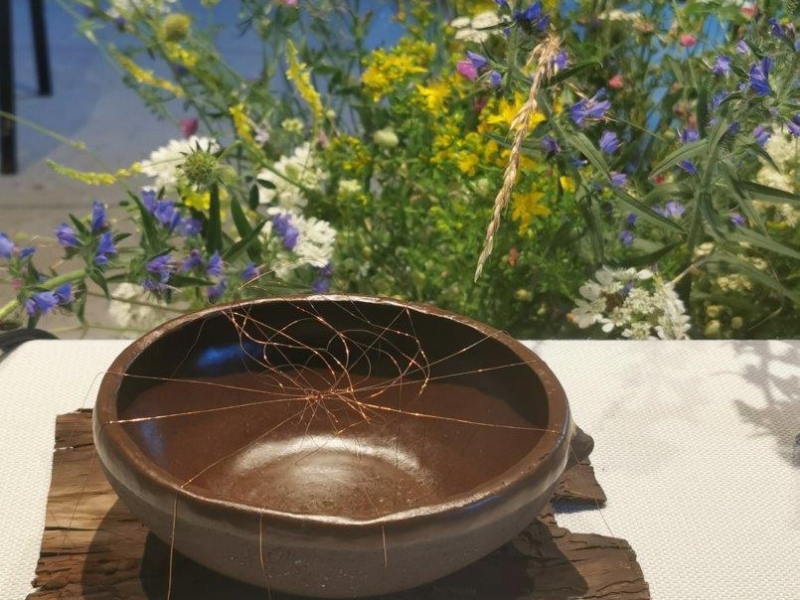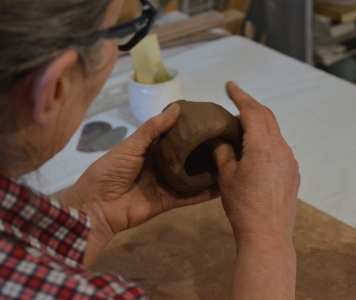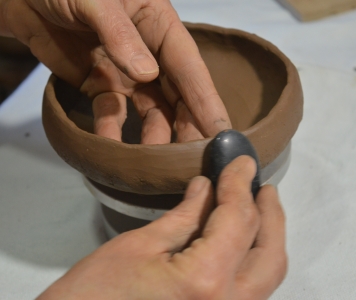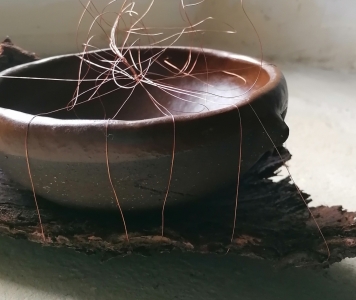
PREHISTORIC BOWL
"MISSING PARTICLES"
Prehistoric pottery - from archeological find to a bowl and a souvenir
We have stepped from the present into the past, for a sustainable future! Our inspiration was the story of fragments of prehistoric dishes from the period 2000 i.e. 1000 years BC, lost in time and space, having experienced their magical moment when, after several years of excavations and research, they are found by archaeologists. The conservator and the potter, who filled in the gaps and recreated the missing particles to make a reconstruction of the prehistoric bowl, became part of this inspiring story. Every fingerprint and palm print, which in ancient times, when creating a bowl, was created by kneading and shaping clay, has left its indelible mark and imprint of that time and man. An imprint that told about the way of life of the communities of that time, what they believed in, how they communicated, cooperated, fought in wars, did various handicrafts and created beautiful works of art - ceramics, jewelry, clothing. Told about what they ate.
Te return to the present has woven new stories - adapted to the current time. A story about a visitor served by a caterer with a prehistoric dish served in a prehistoric bowl adapted to today's needs. And to offer him a bowl, at the farewell, as a modern souvenir of our places, our heritage, our culture. As a souvenir in which the fused elements of earth, water and air are connected by the heat of the sun. The story of offering the visitor more than a souvenir, as much as possible - a pinch of home soil, our land, the land of hilforts / castellieri that adorns the dish. And the story of the Land of Prehistoric Hillforts / Castellieri. All in order for the visitor to feel and understand the generosity of nature, the importance of land and water, the importance of joint creation and to remind them of the precious pottery knowledge of our ancestors. To remember them and pay respect to them. To become part of a story dedicated to a sustainable future in which this rich but overlooked heritage will be revived will be valued, protected and preserved for future generations. Because it is a part of every human being, a part of all of us, a part of mankind.
The bowl was made by Alenka Gololičič, a ceramicist from Gorenji Log, as part of the project Kaštelir - Prehistoric Hillforts and Ethnobotany for Sustainable Tourism and Rural Development - from the Karst (via Brkini, Čičarija and Istria) to Kvarner.
Technical properties of the dish
- The dish is glazed and meets all the conditions for nutritional purposes.
- Volume at least 0.5L - 0.7L.
- Height 6-7 cm
- Width 17-18 cm
- Exterior: coarse-grained unglazed brown
- Interior: glazed with semi-matte transparent glaze, colored with pigments
Materials used
- Clay: Fuchs-ton schwarz S 4015, 1000-1180
- Glaze: translucent matte Samson Kamnik
- Pigments: dark brown Kili D5288 and Botz hellgelb 9042
Production
- From full volume.
- Interior polished with stone due to protruding coarse particles in the clay.
- On the outer surface, prints of sessile twigs.
Baking
- First baking at 1120*C
- Glaze baking at 1050*C
Packaging
- The base is tree bark.
- A bowl and bark are symbolically connected by a copper wire, between which a scroll is inserted with a description of how the dish was created, alongside the contents of the prehistoric "story" and added logos.
Declaration on conformity of the product for contact with food
- Ceramic bowl – glaze migration test
- Test performed by: National Laboratory for Health, Environment and Food
- Chemical testing record no. 2131b-21/87905-21/48631
- Date of sample result: 7 June 2021
- Test number: 21/48631


